Unsure about your French table manners? Click Here to download > > How to avoid these 10 food etiquette mistakes !
- Home ›
- Destinations ›
- Normandy ›
- Rouen and Impressionism
Rouen, Capital Of Impressionism? Light, Shadow, And The River Seine
Published 31 March 2024 by Leyla Alyanak — Parisian by birth, Lyonnaise by adoption, historian by passion
Long known for its cathedral and meandering medieval streets, Rouen in the late 19th century became a magnet for Impressionist painters, Monet being perhaps the most famous. Here’s why the city lays claim to the title “Capital of Impressionism”.
At first the name “capital” may seem like a marketing nickname, but as you explore the Norman city of Rouen in northwestern France, you’ll come across evidence of Impressionists throughout town.
From the façade of its Gothic cathedral to the banks of the River Seine which bisects it, the city inspired impressionism painters who flocked here to admire the lights playing on buildings and landscapes, shifting with changeable weather at different times of the day.
NOTE: Pages on this site may contain affiliate links, which support this site. See full Privacy Policy here.
Impressionism, as we may recall, is all about movement and luminosity, as opposed to the more classical and objective paintings of the time. At its heart was the flow of light on objects and scenes from everyday life, from streets to railway stations to landscapes.
Where did the name “Impressionism” come from?
In 1874, Claude Monet exhibited a painting of the port of Le Havre entitled: “Impression Soleil Levant”, or Impression: Sunrise. An art critic promptly dubbed Monet and his group “Impressionists”. The label was not meant as a compliment.
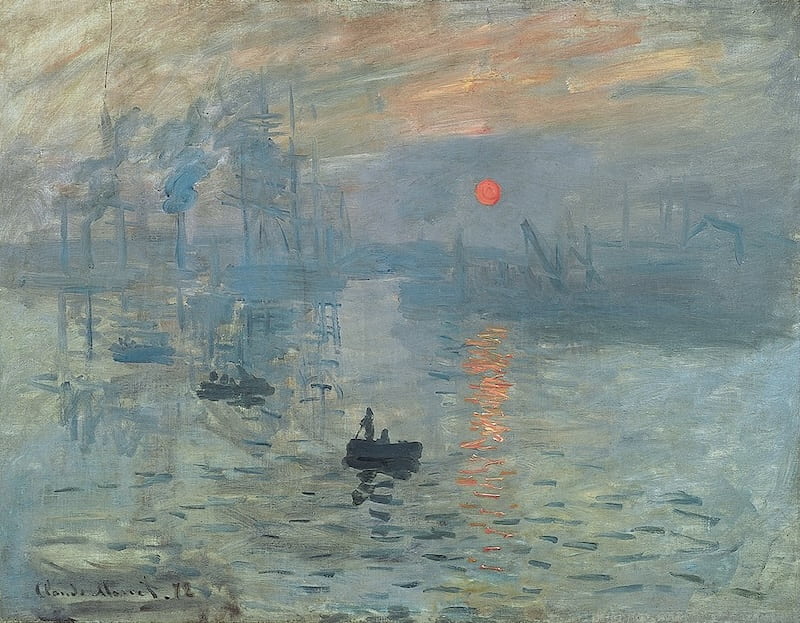 "Impression, Sunrise", the painting that started it all, to be seen in the Musée Marmottan Monet in Paris
"Impression, Sunrise", the painting that started it all, to be seen in the Musée Marmottan Monet in ParisThe story of Impressionism
Impressionism heralded the beginning of “modern art”, a pioneering movement that sought to cut ties with the establishment – by which it was, in turn, rejected.
Having applied to have their works exhibited in the Salon, the official painting and sculpture exhibition, constant rejections prompted these avant-garde artists to start their own exhibition: the Salon des Refusés, of the “refused”.
They were ridiculed. They were called names. Their paintings were panned and only a few – Claude Monet among them – would achieve any recognition in their lifetime. Initially, they would find a better welcome outside France.
Impressionism broke all the rules: it was less defined, less realistic, providing an artist’s impression of a place or setting rather than an exact reproduction. Instead of a static image, Impressionists sought to provide a snapshot in time, a captured moment, a fleeting glimpse. Theirs was a reaction to classicism, to academic painting, at a time – the latter part of the 19th century – of great change in France and the world.
Often, Impressionists painted outdoors to catch the light at the moment of creation, and this is one of the things that drew them to Rouen and to Normandy – the natural light, of course, but also the gentle landscapes, the meandering River Seine, the gorgeous villages, and the proximity of Paris, now within reach with the proliferation of railways.
Beyond Monet, the best known of these Impressionists, we can include Pierre-Auguste Renoir, Gustave Caillebotte, Camille Pissarro, Paul Cézanne, Edgar Degas, Berthe Morisot… and many more.
The story of Impressionism is a fascinating one, and The Private Lives of the Impressionists by Sue Roe is an excellent introduction to this movement and those who belonged to it.
Now, what does Rouen have to do with all this?
HOW DO YOU PRONOUNCE ROUEN?
RWON - but stop before you pronounce the N!
5 Reasons why Rouen deserves to be called “capital of Impressionism”
Whether as a source of inspiration or repository of Impressionist art, Rouen played a vital role in the movement’s development. Today, that role continues as the city celebrates Impressionism with festivals, exhibitions, and ongoing highlights of this fascinating art style, all of which help consecrate it as Impressionism’s capital.
1. One word: Monet
Monet is famous for so much, but one of his major claims to fame is a series of some 30 paintings of Rouen’s Gothic Notre-Dame Cathedral between 1892-1893, mostly of the building’s western façade, of which two are below.
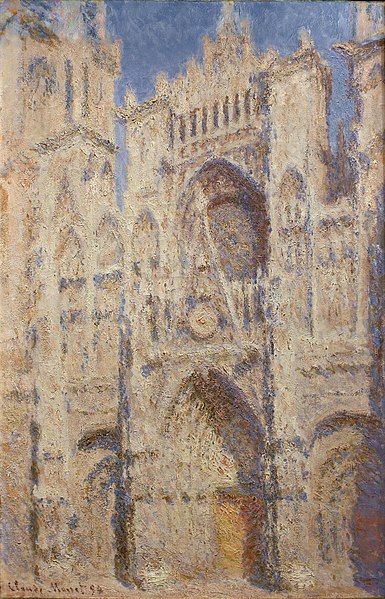
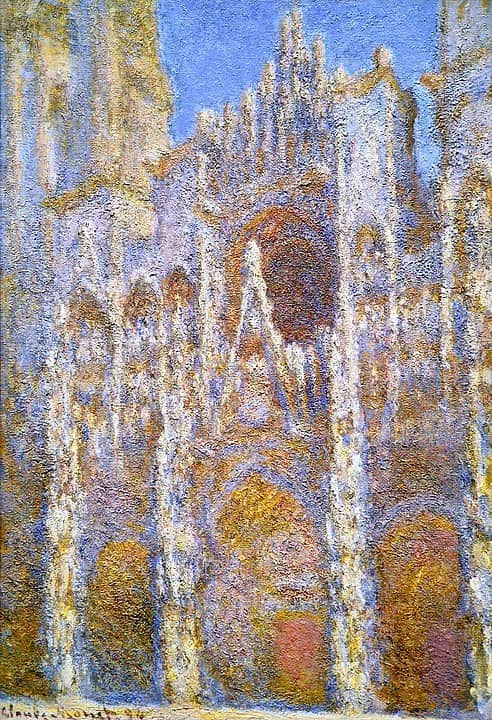
The series was challenging, as the light kept changing, and gave him nightmares during which he dreamed different-colored cathedrals were falling on top of him!
They took nearly two years to paint, and he often worked on many at a time from the windows of a building across the street from the cathedral’s entrance. His studio was right next to the changing room of a women’s lingerie shop, La Grande Fabrique, but it seems he was disinterested, preferring to concentrate on his work.
Monet’s former workshop is now in the midst of renovation: what was once the Hotel des Finances, the equivalent of the tax office or the ministry of finance, will soon house the Rouen tourist office but I was fortunate enough to be able to visit the first floor, and see this:
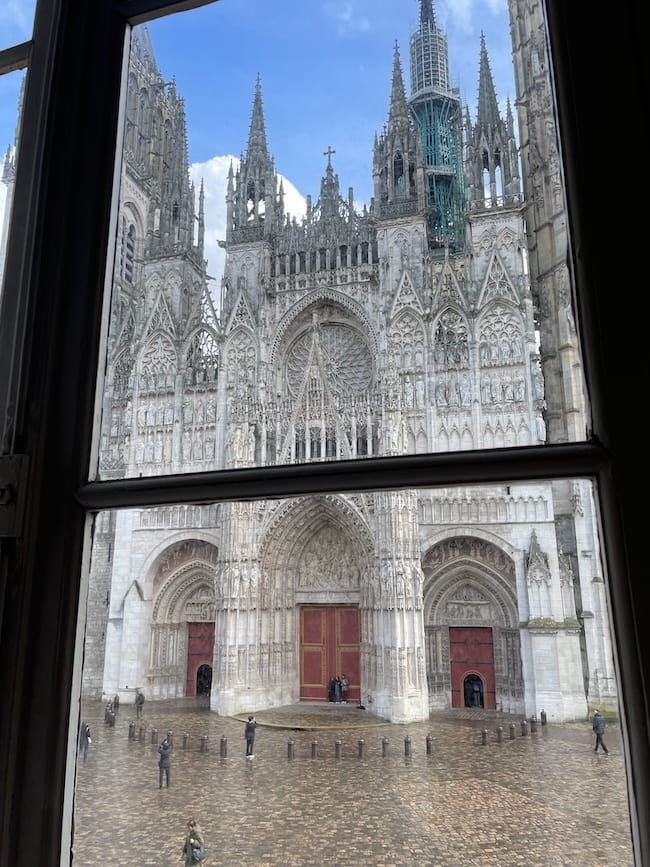 This is similar to the view Monet would have had when painting his cathedral series ©OffbeatFrance/Leyla Alyanak
This is similar to the view Monet would have had when painting his cathedral series ©OffbeatFrance/Leyla AlyanakYes, this is one of the windows from which Monet created his cathedral paintings. Only he would have kept the window open...
2. French Impressionists
While Monet may be the most famous of these, other talented artists wove links to the city of Rouen, forever linking it to Impressionism.
Alfred Sisley, a British artist working in France, loved to paint along the Seine near Rouen. Camille Pissarro moved to Rouen four times, also inspired by the Seine and especially by activity along the port; his stays would yield 69 paintings. “Au Café” by Gustave Caillebotte is another, different example of the city’s inspiration. And there are many more, scattered in museums and private collections.
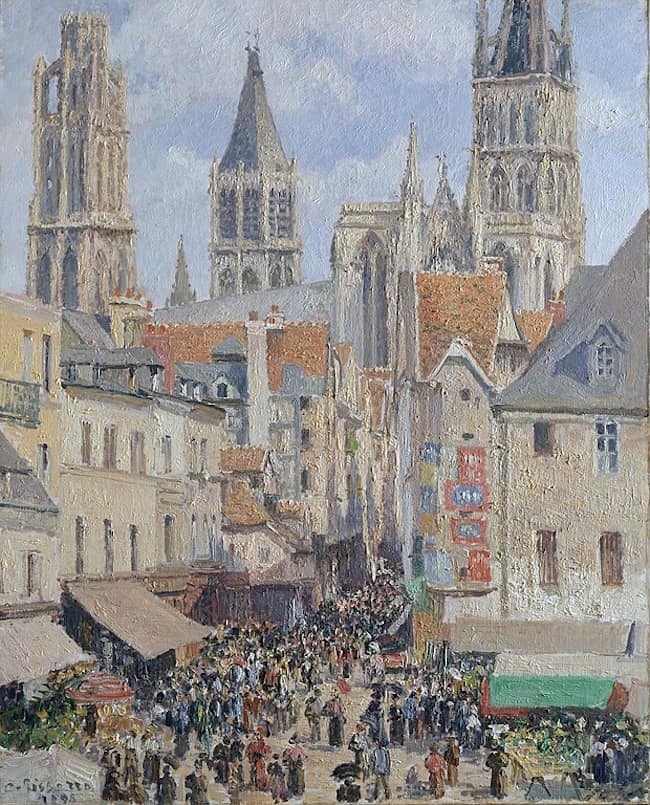 Rue de l'Épicerie, Rouen by Camille Pissarro
Rue de l'Épicerie, Rouen by Camille PissarroIf you walk past Rouen cathedral or through the city’s historic center, you can see for yourself.
The light in Rouen changes constantly, and the sky can rush from rain to sun to rain again in a matter of seconds. You may be tempted to pick up a brush yourself, or at least capture the change with a photograph.
3. Beyond Monet: Rouen's flourishing art scene
In the latter part of the 19th century, Rouen buzzed with artistic energy. Galleries and collectors were supportive of these new styles, creating a welcoming atmosphere that encouraged artists to experiment.
The Rouen Museum of Fine-Arts is a treasure trove, home of France’s largest collection of Impressionist paintings outside the Musée d’Orsay in Paris. It displays works by more than a dozen Impressionists, including 11 by Monet – one of his “Cathedral” series, Gray Weather, is in this museum. Plenty of other Impressionist paintings have their home here, including ten by Sisley.
4. The emergence of the Ecole de Rouen
While Rouen inspired visiting artists, it also gave birth to its own Impressionist movement, the “Rouen School”.
Much of their work was supported and promoted by a rich industrialist, François Depeaux.
This included Monet who, in need of a workshop, was able to settle in Depeaux's studio across from the cathedral to finish painting the series.
The Rouen School would yield such names as Robert-Antoine Pinchon, Charles Angrand, Charles Frechon and Albert Lebourg, whose works are also in the Museum of Fine-Arts.
 "Two Boats in Rouen" by Albert Lebourg of the Ecole de Rouen
"Two Boats in Rouen" by Albert Lebourg of the Ecole de RouenDepeaux was so central to the movement in Rouen that the Impressionist gallery of the museum bears his name.
5. The dancing lights of Rouen
The quality of light in Rouen and its surroundings turned it into a magnet for Impressionists, who thrived on how it moved across the land and sky.
Not only did the dramatic cathedral and the city itself provide irresistible backdrops, but the Seine reflected a play of light on its surface which we see repeated in Impressionist paintings.
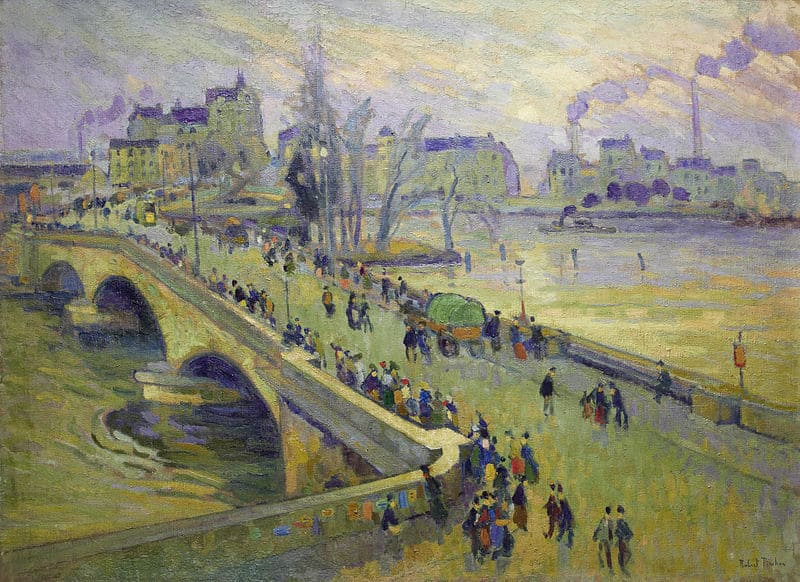 "Pont Corneille, Rouen" by Robert Pinchon of the Ecole de Rouen
"Pont Corneille, Rouen" by Robert Pinchon of the Ecole de RouenFollowing the Impressionist Trail
If Impressionists brought you to Rouen, they can also help you explore beyond the city. Its artists set up their easels throughout Normandy and, seeking refuge from the confusion of Paris, found inspiration in a variety of places.
They found coastlines and villages, panoramic views and small town scenes, light and movement, reflections and change, everything they needed to explore their new approach to painting:
- Le Havre, where Monet grew up. His harbor scene, “Impression, Sunrise”, gave the Impressionist movement its name. Its port and beaches were backdrops not only to Monet but to others, like Raoul Dufy or Eugene Boudin.
- Étretat’s chalk cliffs, which mirror those across the channel, are sculptures in themselves. Their drop into the sea inspired many artists, Monet included.
- Trouville, its beach and Belle Epoque boardwalk ever popular, sparked the muse in Impressionists from Monet to Caillebotte to Boudin.
- Neighboring Deauville, equally elegant, its coastline yet another Impressionist inspiration for scenes of nature or life on the beach.
- Honfleur, whose harbor and skies and timber-framed historic houses have long been attractive to artists, may be wildly popular with tourists but has maintained its artistic ties – it is filled with art galleries and a museum that houses several works by Eugène Boudin, who was born here and had a significant influence on Monet.
- Plenty of Impressionists were seduced by Dieppe, its beaches and cliffs, and especially its port, favored by Monet and Morisot. The chateau above town houses a collection of Impressionist paintings of the city.
- And then there’s Giverny, possibly Impressionism’s most famous destination in Normandy. It was Monet’s home later in life and the place that inspired more than 250 of his works of art. His celebrated Water Lilies, displayed at the Orangerie in Paris, attract a million visitors each year.
Every few years – including 2024, the 150th anniversary of Impressionism – Normandy hosts a Festival of Impressionism, in which Rouen plays a major part, cementing its reputation as Capital of Impressionism and giving us a chance to relive this period fully.
Before you go…
However artistic the city, there are plenty of other things to do in Rouen. For example, if you're a fan of history, don't miss the sites linked to Joan of Arc.
And if art is an important part of your travels, you might enjoy these stories on the fabulous Art Nouveau Ecole de Nancy or, why not, follow in the footsteps of Vincent van Gogh in Provence.
Did you enjoy this article? I'd love if you shared it!

